Recent Why SERVPRO Posts
How to Create an Emergency Response Plan for Your Business
1/9/2023 (Permalink)
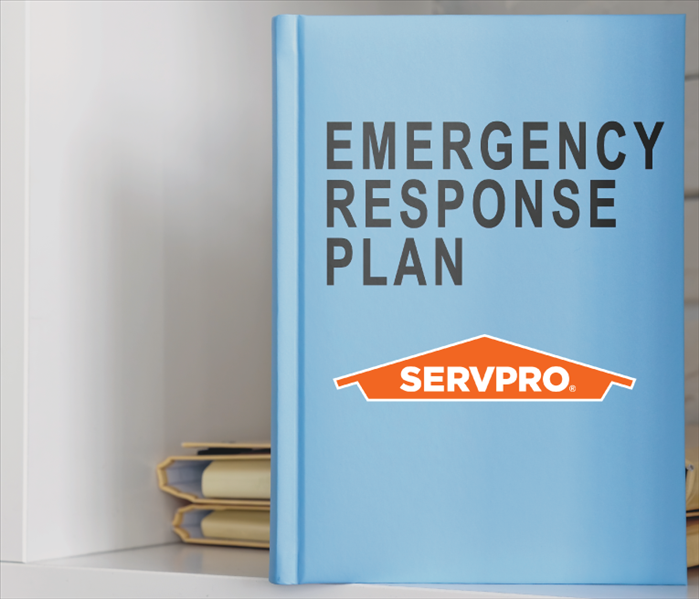 Take the time to develop an Emergency Response Plan.
Take the time to develop an Emergency Response Plan.
How to Create an Emergency Response Plan for Your Business
A business continuity plan is a preparedness strategy that enables an organization to recover quickly after experiencing a disruptive event. The plan includes the necessary processes, procedures, and resources to enable businesses to resume operations as soon as possible following an emergency or disaster. The goal of any business continuity plan is to minimize disruption, maintain normal operations and help organizations recover quickly from incidents such as fires, floods, and power outages. Businesses can use these tips for developing their own emergency response plans:
Step 1: Develop a Business Continuity Policy
A business continuity policy is the first step toward creating an emergency response plan for your business. A good business continuity policy should:
- Be documented. It's important that everyone in your organization knows what's expected of them during an emergency, so a written document outlining the plan will help ensure they're on board and ready to go when it comes time to put it into action.
- Be communicated to all employees. You may think everyone already knows how things work around here, but chances are there are some folks who haven't heard about this new policy yet (or maybe even been invited into the fold). Make sure you get all hands on deck by sending out a message with details about what's going down if an emergency strikes and make sure it gets read by as many people as possible—that way no one will be left in the dark about what needs doing when it really counts!
- Be reviewed regularly. Your company has probably experienced some changes since last year (or even last month), so it makes sense that your plan might need updating from time-to-time as well; unfortunately this isn't always enough though because old habits die hard--meaning some folks may still fall back into old routines instead of following protocol! So how do we fix this problem? By reviewing both policies periodically throughout each year—and especially after major shifts happen within management teams or departments--not only does this ensure nothing slips through cracks but also helps keep everyone focused on staying up-to-date with changing demands too!
Step 2: Review Your Business' Facility, Operations, and Supply Chain
After you've done your research, it's time to review your business' facility, operations, and supply chain. This is where you'll make sure that everything is up to code and ready for whatever comes your way (or at least as much as possible).
You can start by reviewing the basics of how you do business:
- The building's design and construction materials.
- Your workplace safety practices.
- How quickly workers can exit in case of an emergency.
If you have any questions about these areas or need help improving them, then reach out to local fire departments. They're an excellent source of information on what works—and what doesn't—when it comes to emergency planning.
Step 3: Determine Critical Systems and Processes
In this step, you’ll review the critical services and processes that are necessary for the business to function. These are the systems and processes that must be restored first if an emergency occurs. For example, if your business depends on a computer system or software application to run its operations (like accounting), it is essential to identify all of these systems as they will need to be restored sooner than others.
If you have identified any critical systems or processes in your plan, make sure they include:
- A list of all systems and processes that will be needed for operation after an emergency event.
- Details about how each one operates.
- The person responsible for managing each system or process.
- A timeline indicating when each item should be restored after an emergency.
Step 4: Establish Recovery Objectives
As you begin to establish your emergency response plan, it's important to define the problem. A solution without a clear target will be like trying to hit a moving target—you have no idea whether your efforts are effective or not. That's why you should take time to define what success looks like in each phase of your recovery.
Set realistic objectives and goals for yourself, but be ambitious at the same time. You can easily set short-term fitness goals that are within reach if you work hard enough and make them happen!
For example, if you want to develop more muscle mass by focusing on heavy lifting exercises like squats, deadlifts, overhead presses, bench press variations and barbell rows, then consider these tangible results:
- 3 months: gain 5 pounds of lean muscle mass by focusing on compound lifts; increase strength by 10% or more; perform 6-8 reps with 85% your 1RM weight in back squat.
- 6 months: gain 15 pounds of lean muscle mass by focusing on compound lifts; increase strength by 20-30%; perform 8-10 reps with 80% your 1RM weight in back squat.
Step 5: Identify Recovery Strategies
Next, you will want to identify recovery strategies. Recovery strategies are the plans you will use to recover from a disaster or emergency. They include:
- Business continuity plan
- Disaster recovery plan
- Business resumption plan
It's important to note that these three plans are separate processes, but they all help your business get back on its feet after an incident. You can read more about them in our article "Business Continuity Planning 101.”
Step 6: Create an Emergency Response Plan
Once you have created your emergency response plan, make sure it is up-to-date and ready for use.
- Update your plan every year or after any change in the business.
- Check with local government agencies to find out what laws apply to your business, as each state has regulations on how you need to handle emergencies.
- Train employees on the plan before an emergency occurs so everyone knows what they should do when an incident occurs.
Step 7: Test and Evaluate the Business Continuity Plan
Once all the steps are complete, it's time to test your plan. You don't need to do this every year—just once or twice. Make sure you know who will be responsible for each step in case of an emergency, and make sure they know what they're supposed to do.
If you have a business continuity manager who will oversee this testing, then it's a good idea for them to make sure there aren't any holes in the plan that haven't been filled out yet. They can also help with creating new policies as needed: if something happens during testing that wasn't anticipated by your original plan, then it's important for someone like this person (or yourself) to fill out those missing pieces so everything stays accurate over time.
Finally, make sure everyone knows about the business continuity plan in writing! You should put up signs around your office explaining what each part of the process is and where people can find further information regarding their role within it—and remind everyone at least monthly how important these steps are when dealing with emergencies!
Responsibility
As a business owner, it's your responsibility to ensure that your employees are safe during an emergency. But even if you're not the owner of the company, creating an emergency response plan is still important for you. Here's why:
- An emergency response plan will help save lives. If you're in a situation where there's been flooding or fire, having a plan in place can determine whether or not people survive by getting out of harm’s way as quickly as possible.
- A good emergency response plan will also minimize financial losses due to damage and injury claims. Business owners should be aware that they could be held liable if they don't have plans in place to prevent emergencies from happening in their workplace!
The most important thing is to take the time to develop an emergency response plan for your business. The plan should be reviewed and updated regularly so that it’s always relevant and ready for any eventuality.
How To Stay Safe During a Flood
8/24/2022 (Permalink)
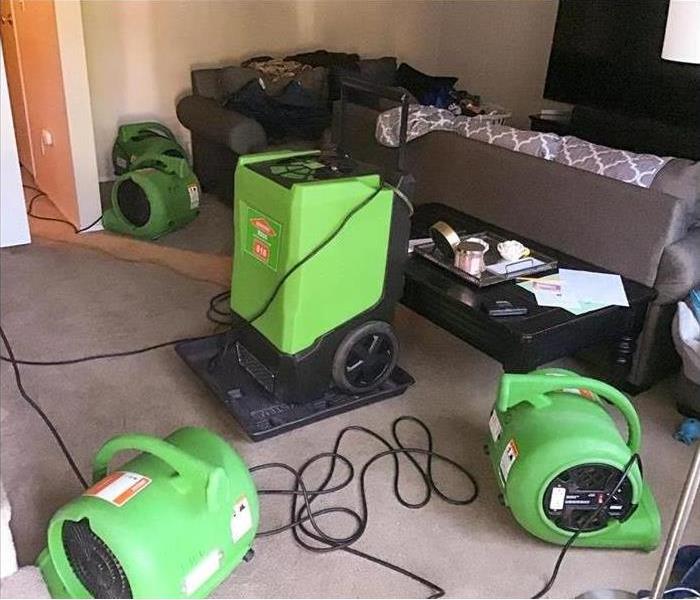 Let us help when you experience storm damage.
Let us help when you experience storm damage.
Flood Safety Tips
Storms can create unexpected circumstances in Sumner, WA. One minute your home may be fine, but the next you have rising waters in your basement. Because the situation can change so quickly, you need to know how to stay safe during a storm-caused flood. Keep these flood safety tips in mind whenever bad weather approaches.
Stay Out of the Water
Did you know that as little as six inches of moving water can cause you to lose your balance? Because it doesn't take high waters, you need to be careful whenever you have to walk through any type of flood. If you must walk through a flood, keep these safety tips in mind:
- Use a walking stick.
- Hold on to something sturdy.
- Walk quickly and cautiously.
While the waters may not be moving in your house, they can still pose a health and safety risk. However, as a homeowner, you cannot always avoid the flooded parts of your space. You also want to avoid standing water outside of your house even if you're in your car.
Avoid Electrical Equipment
Water conducts electricity, so you want to avoid electrical equipment whenever you are in standing water. If you know there is electricity running through your basement flood, you should turn off the power to your home before anyone enters the lower levels for the best flood safety. Even if you are damp and not currently in water, you should avoid the electricity.
Call for Help
Storm-caused flooding can trap you in the upper levels of your home. If you need emergency help during a storm, you should call someone as soon as you can. After the danger has passed, you may need help restoring your home. Getting in touch with storm restoration services can make your cleanup process much easier.
The heavy rains of a storm may cause flooding in Sumner, WA. Knowing the best flood safety techniques can keep you and your home in one piece during a disaster.
5 Common Types of Household Mold
8/15/2022 (Permalink)
5 Common Types of Household Mold
It's not uncommon to discover mold growing in your Puyallup, WA, home. Mold growth can occur under several different circumstances, depending on the type of fungi in question. Before you begin your mold remediation process, you should identify which species is the culprit.
1. Stachybotrys
More commonly referred to as the infamous black mold, Stachybotrys is perhaps the most common type of residential mold. Much like the name implies, it has a dark green or black color and may feel slimy to the touch. It's very common in places that come into frequent contact with water, or in areas that have recently suffered some form of water damage.
2. Alternaria
This species of mold is often confused for black mold, as it thrives under the same damp or high humidity conditions, has a very similar appearance and is just about as common as its cousin. Instead of feeling slimy, Alternaria has an almost velvety texture due to the wispy dark green or brown hairs that sprout on its surface.
3. Chaetomium
Once again, this type of mold growth is quite common in water damaged structures. When it first appears, it boasts a white or gray color before slowly fading to dark brown or black over time. You're more likely to smell this species before you see it, due to its musty odor.
4. Aureobasidium
You should check for this type of fungus behind your wallpaper or on painted wooden surfaces. This mold appears pink or brown in color when it's young and slowly fades to black over time, much like chaetomium.
5. Cladosporium
This versatile species of mold can thrive in both warm and cold environments. You're most likely to find it growing in your carpeting, upholstery and other types of fabrics. It boasts a soft, suede-like texture and green coloring.
You could potentially find several different mold species growing in your home, so it's important that you know which common varieties to look for. Contact mold remediation experts like SERVPRO of Puyallup/Sumner for assistance if you do discover mold growth in your home.
How to Prevent Black Mold in Your HVAC System
7/25/2022 (Permalink)
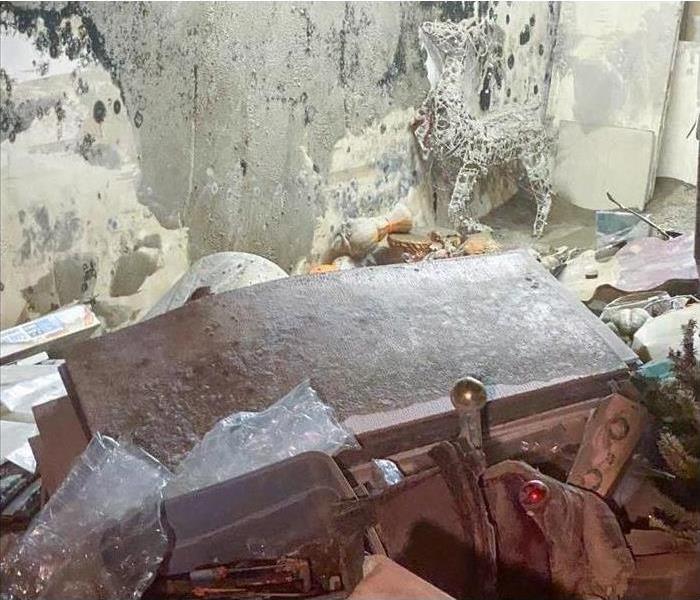 Walls in the basement were damaged by water and mold
Walls in the basement were damaged by water and mold
Black Mold Is Very Dangerous But Easily Preventable
By now, everyone has heard of black mold. In case you haven't, it is a dangerous form of toxic mold that grows in a variety of environments. It is named for its color and can cause a lot of effects, but there are ways to prevent it.
Keep Your Filters Clean
If you use replaceable filters, replace them every 30 to 60 days, depending on your business. If you have washable filters, make sure you wash them regularly with an approved mold preventative cleaner. Not only will this save you money in the long run, but it also prevents other issues.
Look for Wet Spots
Wet spots can appear in several ways. Some of these ways are:
- Brown spots
- Sweating ducts
- Grey areas
- Black spots
When you see wet spots, it is extremely important to dry them as soon as possible because black mold grows very quickly.
Have Your Ducts Professionally Cleaned
You should have your air ducts professionally inspected and cleaned at least twice per year. This should happen in the spring and fall and can prevent mold or mildew build-up. It isn't difficult to find mold cleaning companies in Enumclaw, WA.
Keep an Eye on Humidity
Assuming you have clean ducts, you can use a hygrometer to measure the amount of humidity in, on or near your ductwork. These instruments are not expensive and can be placed almost anywhere you need them. You can also use a portable meter to measure humidity in whatever area you need to.
Fix Water Damage Immediately
In the event of a flood or leak, fix the damage immediately. It takes just 24 to 48 hours for mold to start to grow. Damaged ductwork and drywall need to be removed and replaced before mold has a chance to form.
Black mold is very dangerous but easily preventable. With a little bit of work, you can stop a major problem before it starts.
How Insurers Benefit from the SERVPRO Franchise Model
6/29/2022 (Permalink)
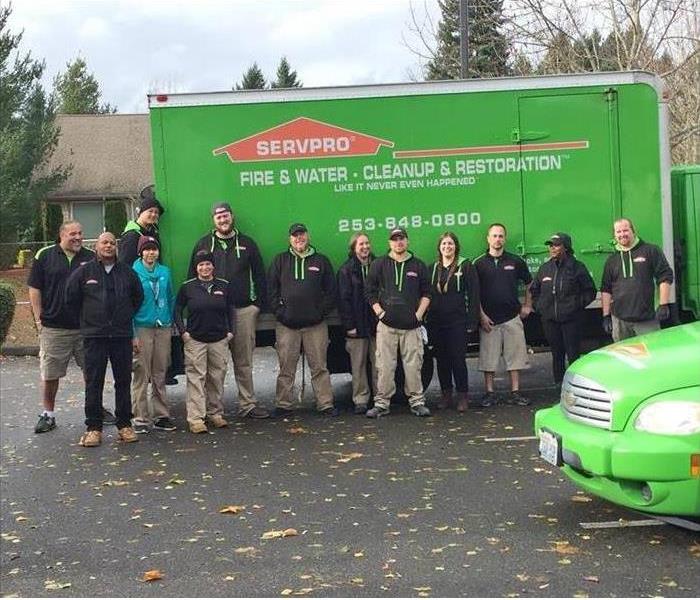 Our team prides ourselves in being "Faster to any size disaster," and provides a 24-hour emergency service 7 days a week, 365 days a year.
Our team prides ourselves in being "Faster to any size disaster," and provides a 24-hour emergency service 7 days a week, 365 days a year.
How the SERVPRO Franchise Model Benefits Insurers
When a claim is filed that requires remediation and restoration services in Sumner, WA, it means that work needs to get started fast. Since it is vital the work is done right, choosing a SERVPRO franchise ensures that happens. This innovative business model was developed to maximize every part of the restoration process. Below are four reasons to choose this franchise.
1. Locally Owned
With more than 1,900 locations throughout the United States and Canada, help is right around the corner. No matter the disaster, you can be confident that you will have 24/7 access to a person to get the claim rolling and a team of professionals within two hours of nearly any zip code.
2. Corporate Backed
Along with have a local team right around the corner, you also get the peace of mind that the team is backed by a corporate team ready to serve. From experts in insurance to large loss emergency services, corporate backing means ongoing support and expertise to handle any size of a disaster.
3. Ongoing Training
As a franchise, it must adhere to the strict standards set by corporate. That means that all local technicians have been IICRC certified and receive ongoing training. Each new franchise must participate in a 15-day training program at the corporate training facility. After that, every technician must complete regular training to maintain certifications and stay up to date on the latest in the industry.
4. Preferred Vendor
As an insurance provider, you want the claim to go as smoothly as possible. When you chose a local franchise backed by a corporate team, it means you are getting the services of an established company. With more than 50 years of experience in the industry, SERVPRO has become a preferred vendor for many companies.
A SERVPRO franchise is much more than a reliable, local team of professionals. When choosing it is a provider, you get the backing of a corporate support team and a brand name trusted for decades.
How To Save Books and Documents From Water Damage
2/4/2022 (Permalink)
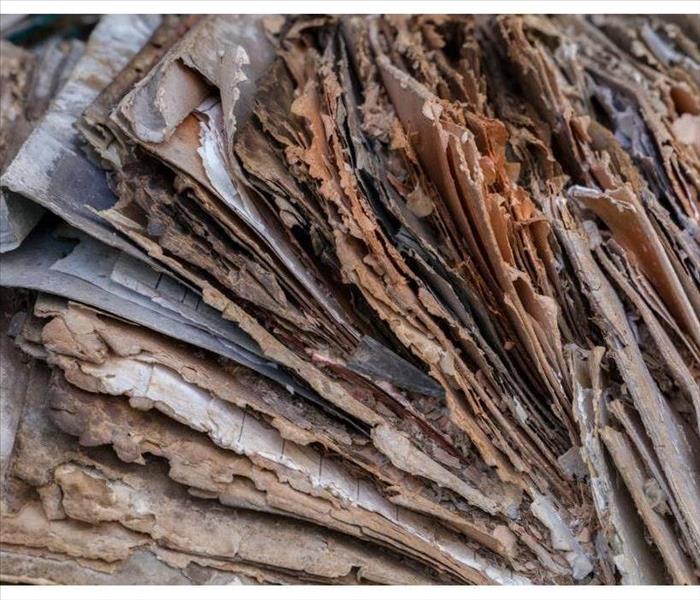 Document restoration is a delicate process, but SERVPRO professionals, have the training and tools necessary to do the job well.
Document restoration is a delicate process, but SERVPRO professionals, have the training and tools necessary to do the job well.
How To Prevent Water Damage To Books And Documents
When your home has been hit by flooding or other water damage, your family documents, treasured diaries, and other important books and papers are at serious risk. The moisture and humidity are certain to do serious harm. What can you do to prevent further damage? How should you handle document restoration?
Identify the Extent of the Damage
The first step is to identify the type of damage your papers, documents, and books have suffered. For the best treatment results, you need to identify how much water you'll be dealing with:
- High Moisture Content: High humidity or a light sprinkling of water through an open window could cause pages to curl or become discolored. Without attention, mold could develop in affected areas.
- Absorbed Water: A leaky window near a bookshelf or a stream of water from an upstairs room into a lower study could expose books and documents to damage within the very fibers of the papers.
- Submerged Items: Flooding is a cause of serious damages. Water gets between all the pages and works its way through entire storage boxes or file cabinets. In some cases, writing becomes so blurred that documents are no longer readable.
Contact a Professional
As soon as you can safely do so, contact a professional to dry and restore important documents and treasured papers. SERVPRO provides document restoration within their own facilities. By handling document drying internally, costs can be kept lower, and quality can be monitored directly.
Inventory Affected Books and Documents
While you wait for drying and restoration professionals to arrive, resist the urge to move papers around. When documents are wet, they are at their most fragile state. In some cases, those papers may have been exposed to toxic materials. Instead of moving books and documents, make a list of the documents that have been affected (to the best of your ability without moving them.) It's helpful to know if there are birth certificates, family histories, or financial records in the stack.
Document restoration is a delicate process, but SERVPRO professionals in Auburn, WA, have the training and tools necessary to do the job well. The best time to contact them is before further damages are done.
Using Bread To Understand Mold
1/13/2022 (Permalink)
 All mold needs an organic food source, and most molds have favorites.
All mold needs an organic food source, and most molds have favorites.
Understanding Mold Through The Use of Bread
You have many responsibilities for maintaining your home in Graham, WA, and staying mold-free is an important one. Reviewing your experience with bread mold is a great way to understand the impact of mold in your home. Why does mold grow on bread?
1. Mold spores are everywhere.
Most people store their bread in a plastic bag, yet mold will still grow thanks to the fact that spores are lightweight and travel through the air. The little bit of exposure your bread gets from opening the bag is enough to allow spore-containing air to enter. This is similar to the way mold spores get in your home: traveling on the air and entering through doors, windows and vents.
2. Mold grows in a moist environment.
You don’t see croutons covered in mold and that’s because there is not enough moisture. People love bread when it is soft and moist, and that moisture is exactly what fungus growth needs to thrive. That’s why controlling relative humidity and repairing water leaks are both important jobs to prevent mold growth in the home.
3. Mold needs a food source.
All mold needs an organic food source, and most molds have favorites. When it comes to bread mold, there are certain varieties that tend to colonize on bread. This is also true for homes, since most building materials are made from cellulose-based materials, and the molds that prefer that food source tend to colonize there.
Can’t You Just Change the Temperature?
While most molds prefer a warmer temperature, many varieties can handle a cooler environment, which is why you find fridge mold. You can prevent mold by freezing bread, but you can’t freeze your home.
With the lessons learned from bread mold, you can see that moisture control is the key to preventing household mold problems. If you already have mold, it’s important to get help fast since mold multiplies rapidly. Expert mold remediators are knowledgeable and use a variety of techniques to help prevent the further spread of mold during the clean-up process.

 24/7 Emergency Service
24/7 Emergency Service





